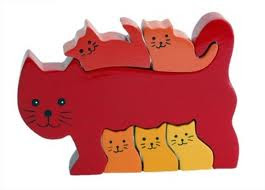Wooden puzzles are an up-to-date version of a traditional toy, and are designed with education in mind. They are exceptional value for money considering the number of positive rewards you can get out of just one toy. It's an activity that can be shared with friends or family, one which provides a tremendous sense of satisfaction when the last piece is fitted, making the child want to do the puzzle again and again.
Here are just some of the benefits your child can get out of a quality wooden puzzle.
Provides a focus for chatting about what is shown in the picture Improves the child's hand-eye coordination Develops the child's ability to rationalize size/shape recognition Encourages the steps that are taken by the child in a logical sequencing process Enhances spatial awareness Develops the child's ability to identify alphabet letters later because doing puzzles has helped them to recognize shapes Encourages perseverance in completing an activity once it is started Builds a child's confidence and sense of achievement when they complete the puzzle Above all doing puzzles is fun!
Why a Wooden Puzzle?
Any toys played with by young children undergo a fair beating and therefore should be made of sturdy materials. Wood is perfect for making puzzles. It never bends out of shape so the picture never creases, and it can even be chewed!
How to Choose a Wooden Puzzle
Several factors should be taken into consideration when choosing an appropriate puzzle for a child. Here are some rough guidelines to help you pick the right puzzle.
The Photo or Illustration
The first thing you see when looking at any puzzle is the photo or illustration of the completed puzzle. On choosing, remember that the image should have some educational value but also be something the child can relate to. If the image is familiar to the child or fulfills the educational objective (like learning colours or naming objects), the experience of completing the puzzle will be all the more enjoyable, satisfying and productive. The image should be easily recognizable so the child can identify it as something they see around them in their everyday life. It should also have distinguishable features to help them decide where to put the piece so that it ends up in the right place.
Ease of Fit and Handling
Needless to say, children have small hands, so they will find it easier to pick up and place a puzzle with large pieces. If the pieces are thick and have pegs to hold onto, like all our wooden puzzles for the very young, it will be easier still.
Does the Puzzle Have a Matching Image Underneath?
Having a matching image in the puzzle tray means the puzzle is self-correcting. In other words the child can do the puzzle without the help of an adult, using the image underneath to guide them. It is the perfect way to allow the child to feel confident they are placing the piece correctly, giving them a great sense of achievement.
Does the Piece Fit All the Way Into its Tray?
We feel that a puzzle piece should fit completely inside the puzzle tray. There are many puzzles on the market today, aimed at the very young, that have pieces that protrude above the puzzle. Although they many look attractive, they are not a clear indicator to the child that the piece has been fitted correctly as it does not fall all the way into the tray.
Number of Pieces
The number of pieces is fundamental for the child's success in getting the most out of a puzzle. A puzzle should be challenging but not too difficult. If the puzzle is beyond the child's capabilities, they will get frustrated and lose interest. If the puzzle has too few pieces, it will be too easy, and so may not serve its purpose as an educational toy.
Each child is of course different, but generally speaking we recommend the following (bear in mind, if the child is a keen puzzler, they will need more pieces than usual to maintain the challenge): 1 to 2 years - 4 to 5 pieces 2 to 3 years - 5 to 10 pieces 3 to 4 years - 10 to 36 pieces 4 to 5 years - 36 pieces and up
Happy Puzzling!
A few short paragraphs are not really enough to show how important a jigsaw puzzle can be for a child's development. Nevertheless, we hope we have made the task of choosing the right puzzle just that little bit easier so that your child or relative can enjoy the countless benefits these timeless toys have to offer.
From all of us here at Willis Toys, we thank you for your time and wish you happy puzzling!
Mark Willis
http://www.willistoys.co.uk/
Article Source: http://EzineArticles.com/6495061

0 comments - Skip to Post a Comments
Post a Comment